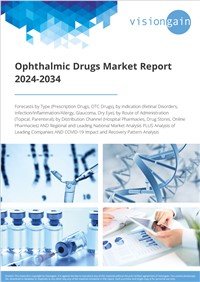The Ophthalmic Drugs Market Report 2024-2034: This report will prove invaluable to leading firms striving for new revenue pockets if they wish to better understand the industry and its underlying dynamics. It will be useful for companies that would like to expand into different industries or to expand their existing operations in a new region.
The global ophthalmic drugs market is experiencing substantial growth, and this can be attributed to several key factors. The increasing prevalence of ophthalmic disorders, including conditions like glaucoma, macular degeneration, diabetic retinopathy, and dry eye syndrome, is driving the demand for more effective pharmaceutical treatments. As the world’s population ages and lifestyles evolve, the incidence of these eye-related disorders continues to rise, creating a sustained need for innovative drugs to address them.
The presence of a robust emerging pipeline of drugs is contributing significantly to market growth. Pharmaceutical companies are actively investing in research and development efforts to develop new and improved ophthalmic medications. These pipeline drugs hold the promise of enhanced therapeutic options and more targeted treatments, further fueling the market’s expansion. Together, these factors underscore the dynamic and evolving nature of the global ophthalmic drugs market, which is poised for continued growth in the foreseeable future.
Side Effects of Drugs Likely to Challenge Industry Growth
The utilization of topical drugs can result in various side effects, encompassing temporary vision cloudiness, allergic responses, visual disruptions, and sensations of stinging, burning, or itching. Additionally, more infrequent side effects encompass sudden alterations in vision, severe headaches, tunnel vision, eye discomfort, pain behind the eyes, and indications of potential new eye infections, such as swelling and drainage. Consequently, the presence of these side effects linked to topical steroidal drugs has the potential to impede market growth.
The challenge posed to the ophthalmic drugs market in developing nations by drug side effects is a complex issue. Resolving this concern demands a holistic approach that encompasses various measures, such as enhancing healthcare accessibility, improving medical infrastructure, fostering patient education, countering counterfeit drug proliferation, and establishing stringent regulatory frameworks to uphold the safety and effectiveness of ophthalmic medications.
What Questions Should You Ask before Buying a Market Research Report?
- How is the ophthalmic drugs market evolving?
- What is driving and restraining the ophthalmic drugs market?
- How will each ophthalmic drugs submarket segment grow over the forecast period and how much revenue will these submarkets account for in 2034?
- How will the market shares for each ophthalmic drugs submarket develop from 2024 to 2034?
- What will be the main driver for the overall market from 2024 to 2034?
- Will leading ophthalmic drugs markets broadly follow the macroeconomic dynamics, or will individual national markets outperform others?
- How will the market shares of the national markets change by 2034 and which geographical region will lead the market in 2034?
- Who are the leading players and what are their prospects over the forecast period?
- How will the industry evolve during the period between 2024 and 2034? What are the implications of ophthalmic drugs projects taking place now and over the next 10 years?
- Is there a greater need for product commercialisation to further scale the ophthalmic drugs market?
- Where is the ophthalmic drugs market heading and how can you ensure you are at the forefront of the market?
- What are the best investment options for new product and service lines?
What are the key prospects for moving companies into a new growth path and C-suite?
You need to discover how this will impact the Ophthalmic Drugs Market today, and over the next 10 years:
- Our 284-page report provides 125 tables, 168 charts/graphs exclusively to you.
- The report highlights key lucrative areas in the industry so you can target them – NOW.
- It contains in-depth analysis of global, regional and national sales and growth.
- It highlights for you the key successful trends, changes and revenue projections made by your competitors.
This report tells you TODAY how the Ophthalmic Drugs Market will develop in the next 10 years, and in line with the variations in COVID-19 economic recession and bounce. This market is more critical now than at any point over the last 10 years.
Forecasts to 2034 and other analyses reveal commercial prospects
- In addition to revenue forecasting to 2034, our new study provides you with recent results, growth rates, and market shares.
- You will find original analyses, with business outlooks and developments.
- Discover qualitative analyses (including market dynamics, drivers, opportunities, restraints and challenges), cost structure, impact of rising ophthalmic drugs prices and recent developments.
This report includes data analysis and invaluable insight into how COVID-19 will affect the industry and your company. Four COVID-19 recovery patterns and their impact, namely, “V”, “L”, “W” and “U” are discussed in this report.
Segments Covered in the Report
Type
- Prescription Drugs
- OTC Drugs
Indication
- Retinal Disorders
- Infection/Inflammation/Allergy
- Glaucoma
- Dry Eye
Route of Administration
- Topical
- Parenteral
Distribution Channel
- Hospital Pharmacies
- Drug Stores
- Online Pharmacies



